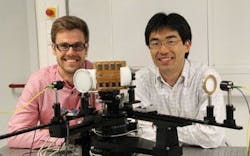Terahertz beam steering and focusing possible with German/Japanese device
Marburg, Germany and Tokyo, Japan--In a close collaboration, researchers from the University of Marburg and the University of Tokyo have demonstrated a device that allows for an electric and flexible focusing and steering of terahertz (THz) waves. The ability to redirect and focus THz beams is important for terahertz communication systems that work with directed links between emitters and receivers. Yet, the position of THz emitters and/or receivers (or the distance between them) is likely to change from time to time, as we move with a laptop or other mobile devices freely in a room. Moreover, walking persons or moving objects might block the link. Hence, it is crucial to have the ability to redirect THz beams or to vary their divergence or focus.
Other application fields include remote sensing and the inspection of industrial goods. The device was developed by Yasuaki Monnai in the group of professor Hiroyuki Shinoda at the University of Tokyo. It is based on a sub-wavelength array of metal cantilevers that can be micromechanically actuated by electrostatic forces such that tunable gratings of different periodicity can be created. Tuning the grating pattern allows for a shaping of the wavefront of the diffracted radiation and, hence, to vary the direction of the THz beams. Furthermore, the divergence of the THz beam can be controlled.
The characterization experiments were performed by Kristian Altmann and Yasuaki Monnai in the group of professor Martin Koch at the University of Marburg. In the first proof of concept, the steerable range at 0.3 THz exceeded an angle of 40 degrees. The accomplished beam directions and the field profiles agree well with theoretical expectations.
REFERENCE: Y. Monnai et al., Optics Express 21, 2, 2347-2354 (2013) or http://dx.doi.org/10.1364/OE.21.002347.
SOURCE: University of Marburg; http://www.uni-marburg.de/aktuelles/news/2013a/0128b

Gail Overton | Senior Editor (2004-2020)
Gail has more than 30 years of engineering, marketing, product management, and editorial experience in the photonics and optical communications industry. Before joining the staff at Laser Focus World in 2004, she held many product management and product marketing roles in the fiber-optics industry, most notably at Hughes (El Segundo, CA), GTE Labs (Waltham, MA), Corning (Corning, NY), Photon Kinetics (Beaverton, OR), and Newport Corporation (Irvine, CA). During her marketing career, Gail published articles in WDM Solutions and Sensors magazine and traveled internationally to conduct product and sales training. Gail received her BS degree in physics, with an emphasis in optics, from San Diego State University in San Diego, CA in May 1986.
